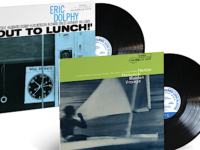by Nick DeRiso
Bassist Charles Mingus, an enlightening yet stormy presence, clearly felt he had unfinished business with some of his earlier work. So, he used “Mingus Mingus Mingus Mingus Mingus” and a move to the more creatively open Impulse! label to take another pass at them.
That turned into a dramatic remodeling project for Mingus.
In fact, he rips them up, pieces them back together, speeds them up, slows them down, drives them into the ditch, then reattaches all the dented parts.
“MingusX5,” as I always called it, would eventually become less about reevaluation than about true rediscovery — and, for me, every bit the creative triumph of more widely praised efforts like “The Black Saint And The Sinner Lady,” “Mingus Ah Um” and the posthumous “Epitaph.”
Mingus was still working within a Dixieland-style collective improvisation, and amid this spectacular din of sound, we should probably expect complexity. The marvellously complex Mingus doesn’t disappoint.
Adept at both an almost naughtily playfulness in the opener — a redo of “Haitian Fight Song” called “II B.S.” (sound out the Roman numeral, then refer to the vernacular for the following two letters), featuring tenor saxist Booker Ervin and pianist Jaki Byard — as well as the sensual curiosity of the “Nouroog” update “I X Love,” Mingus is freed to experiment as composer, arranger and performer.
Mingus was also playing around with his band, updating the same basic cast as 1963’s “Black Saint” by adding reedman Eric Dolphy — who completes one of the very best groupings ever constructed by the mercurial bassist. “MingusX5” allows every player to somehow make the other better.
 A more turbulent theme can be found in “Celia,” in keeping with its subject matter. (Mingus is said to have written it in tribute to his ex-wife, and even includes at one point just a hint of “The Lady In Red,” referencing her hair color.) Altoist Charlie Mariano is highlighted here, as well as on “I X Love,” and he adds to the innate drama.
A more turbulent theme can be found in “Celia,” in keeping with its subject matter. (Mingus is said to have written it in tribute to his ex-wife, and even includes at one point just a hint of “The Lady In Red,” referencing her hair color.) Altoist Charlie Mariano is highlighted here, as well as on “I X Love,” and he adds to the innate drama.
That tension finds its zenith during an amped up take on “Better Get Hit in Yo’ Soul,” presented in 6/8 time yet boasting an interesting countermelodic grit. On the closing “Hora Decubitus,” a rewrite of “E’s Flat Ah’s Flat Too” which the bassist said meant “At Bedtime,” Mingus’ 10-member group — with a notable turn at this point by Dolphy — turns up the fire, putting a fierce exclamation point on this album.
But even in moments of reflection, however, Mingus challenges himself, and those around him, to dig deeper.
Given an opportunity to pay tribute to a childhood hero in Duke Ellington, on “Mood Indigo” (embedded below), Mingus sets the tone with a virtuoso solo. Later on “Theme For Lester Young” (also known as “Goodbye Pork Pie Hat”), there is a quiet, almost tenderly reflective solo from Ervin — in keeping with the tune’s origin: Mingus reportedly wrote it at a New York club on the night he heard of Young’s passing.
That underscores the tough spirituality that still makes Mingus so intriguing.
He was a straight talker but also a seeker of things, someone who questioned it all — including himself and his own work. As well known for his volatility as for his ambition, Mingus took everyone on his journey — starting with the sidemen.
That helped Mingus, when everything came together, draw out such memorable performances from those around him. “MingusX5” was one of those times.
- How Deep Cuts on ‘Music From Big Pink’ Underscore the Band’s Triumph - July 31, 2023
- How ‘Islands’ Signaled the Sad End of the Band’s Five-Man Edition - March 15, 2022
- The Band’s ‘Christmas Must Be Tonight’ Remains an Unjustly Overlooked Holiday Classic - December 25, 2016




